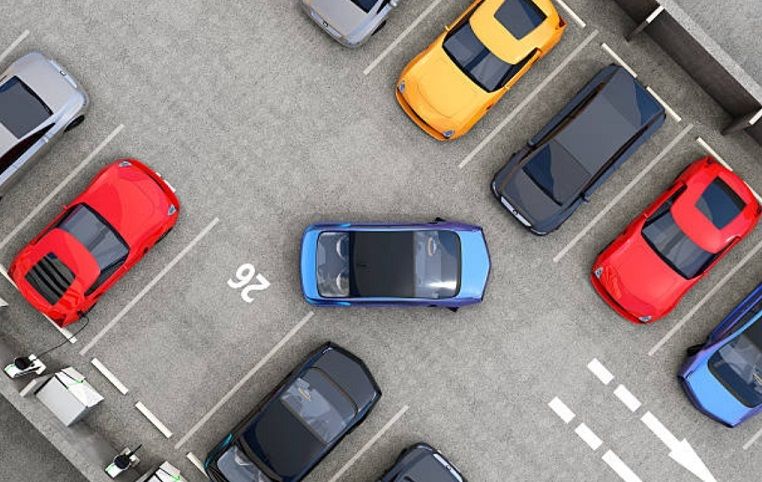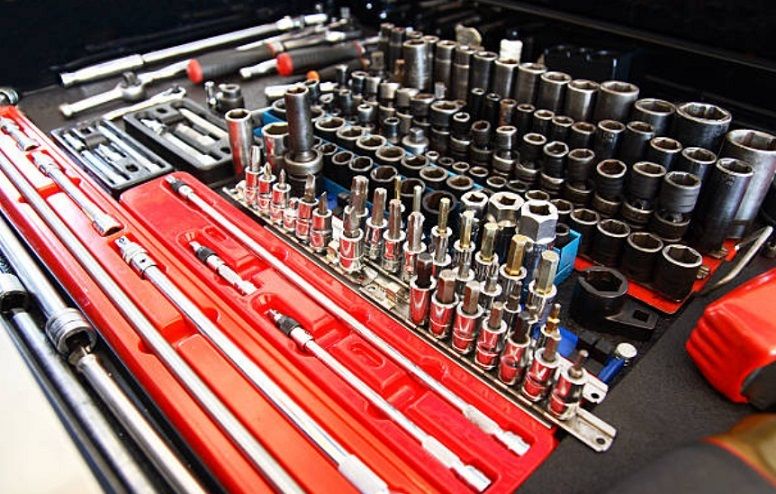Reviews
Best Garage Parking Aid & Sensors Reviews

Do you struggle to park the car inside your garage? Maybe you just fear the day that you or a family member hit something while parking. There are ways to help you park inside the garage and are simple to set up.
Below are some of the best garage parking aids on the market right now. Since all garages are not the same I highlighted several parking aids. Some are ceiling mounted while others are mounted to the floor.
Editor’s Recommendation: Top 5 Garage Parking Aid
 |
Camco AccuPark Parking Mat | Check Price | |
 |
MAXSA Innovations Garage Parking Laser | Check Price | |
 |
Precision parking aid by Park Zone | Check Price | |
 |
Car door protector for garage walls by Highland | Check Price | |
 |
Double garage parking aid ball guide system by Let’s Innovate Life | Check Price |
5 Best Garage Parking Aid to Prevent Accidents
1. Camco AccuPark Parking Mat
With over 900 reviews the Camco is one of the best garage parking mats available.
Installation is very simple with the adhesive strips under the mat. You will need to make sure the garage floor is even and clean before installation. If you don’t like the idea of having a mat on the floor I would look at other options.
The Camco parking mat has 2 humps on it. The smaller hump is there to signal you when you are close to the spot. The larger hump will tell you when to stop the car. You will have to drive slow in order to feel the humps and prevent jumping over the mat. If you have a truck with larger mud tires you may not feel the mat.
Some have commented on the adhesive strips not sticking to their garage floor. To remedy the problem one guy used 3M adhesive tape to install the parking mat.
Pros:
- Easy installation
- Reflective strip for visibility
Cons:
- Possible tripping hazard
- Difficult for larger tires
2. MAXSA Innovations Garage Parking Laser
The Maxsa garage parking laser is a ceiling mounted parking aid. It is available in single laser or dual laser with the option of an LED light.
Installation is simple and requires a screwdriver or drill to mount the parking aid to the ceiling. It does require a free outlet to power the unit so make sure you have one nearby. The power cord for the single laser unit is 9 feet long. The cord on the dual laser unit is only 6.5 feet long. I have no idea why the cords are different lengths.
Setting up the unit is fairly simple. You park your car in the desired spot after installing the laser unit. Next aim the laser in the desired spot on the vehicle. It can be on your wind-shield or hood just as long as you can see it when parking. Now when parking your car you will know to stop when the laser reaches that point.
The laser is motion sensing and will stay on for 15 seconds after no motion is detected. It seems to detect motion as you are about halfway into the garage.
Pros:
- Easy installation
- Out of the way
Cons:
- Requires a free power outlet nearby
- Uses lasers
3. Precision parking aid by Park Zone
Attaching foam or rubber balls to strings in your garage to tell you when to stop when pulling into said garage is simple in its design but also not perfectly effective in the long term. What if the ball on the string falls off? It doesn’t look too impressive in your garage either.
Park Zone’s parking aid resembles a traffic light. While it also hangs from the ceiling of your garage, it senses whenever your car enters a garage and will light up when you are close to hitting something in the garage. This is a little more stable than parking aids that utilize a ball on a string.
Park Zone’s aid is also a bit easier to set up than parking aids that use a ball. It mounts into a wall with screws, which makes your garage much more aesthetically pleasing than ball-and-string parking aids. It also clears up room in your garage, as ball-and-string parking aids can crowd a garage.
You’ll need to stock up on batteries when using Park Zone’s parking aid. It uses 4 AA batteries and they are not included. This can be a problem, because if Park Zone’s parking aid runs out of battery life, you won’t have a working parking aid in your garage.
4. Car door protector for garage walls by Highland
If ball-and-string parking aids are flimsy and can crowd a garage and light-based parking aids can run out of power, maybe the best option is to just install protectors on the walls of your garage.
A creation by Highland, their parking aids represent strong rubber cushions that will absorb impacts from any vehicle that happens to hit the wall of a garage. This is very good for anybody who does not want to deal with any other kind of garage parking aid, be they lights installed in the wall or a bright ball hanging on a string.
Highland’s car door protector easily mounts to any wall of your garage without using any hardware. This is fantastic for anybody who does not want to deal with traditional garage parking aids, which require some semblance of assembly. There is no assembly for Highland’s protectors.
However, Highland’s protectors only withstand certain impacts. If you happen to pull into your garage too quickly, the protectors may not perfectly prevent against damage. They are also black in color, meaning they will be difficult to see when in a garage that is not lit.
5. Double garage parking aid ball guide system by Let’s Innovate Life
Unless you want to keep it lighted constantly, parking in your home’s garage can be troublesome. This is especially true if it is dark inside the garage, and hitting something while parking inside of the garage can happen.
Fortunately, Let’s Innovate Life has created a system that hangs a ball from a string to let you know when to stop your car when pulling into your garage. The ball is bright yellow and very easy to see even if it is dark inside of the garage as well.
Let’s Innovate Life’s parking aid also contains a string that is adjustable up to eight feet from the ceiling. Since most garages are about 14 feet from the floor to the ceiling, this is incredibly useful.
Anybody who possesses any form of DIY method to do something like this will not be impressed with Let’s Innovate Life’s garage parking aid. The string is no better than a fishing line and the ball hook used to hang the ball is no different than any other hook that is used to hang a string from. The ball itself is no brighter than a tennis ball, and is made of similar material.
It is possible to gather similar materials and accomplish the same exact thing that Let’s Innovate Life’s parking aid does.
Types of Parking Sensors:
Not all parking attendants are the same and in some cases systems that execute the maneuvers are confused automatically with others that simply alert us to the proximity of obstacles. So are the different types of parking attendants that are in the market.
Under the denomination of “Park Assist” , the manufacturers offer multitude of systems of help to the parking with different characteristics that suits to know and have clear to know what is what we are paying.
The first thing we need to know is that in many cases they call Park Assist systems that simply alert us by means of sounds or lights of proximity with an obstacle, while others perform the maneuver in a semi-automatic way or even remotely, with the driver in the outside of the vehicle.
Non-automatic parking attendants
This type of assistants are the most frequent and are limited to helping us to detect the distance between the ends of our car and the columns, the wall, the bumper of the car that we have behind, etc. Here there are basically 3 types of assistance: acoustic, using lights or cameras. In many cases several of them are combined and it is very common for us to have sound alerts and a reversing camera, for example. Let’s see each type.
- Sound parking assistant : it is a very frequent system. We must differentiate between those that only have sensors in the back and those that have them both in the front and back. This type of assistants is very practical because they allow the driver to continue paying attention to the perimeter of the car and, for example, make sure that a pedestrian or a cyclist does not approach the rear-view mirrors while calculating the distance “by ear” by reversing. However, this system is useless for deaf people .
- Parking assistance with lights : in some models, the assistant has a small display that shows several colored LEDs that change from green to red as we approach the obstacle. The problem with this system is that it forces us to look at the display and lose sight of the rest of the problems we may have. For deaf people it is a good help. It is usually offered in combination with sound alerts .
- Parking attendant with camera : the most basic have a camera in the rear, while the most complex have 360º vision and even active lines of maneuver that tell us the trajectory that the vehicle will follow depending on the position of the wheels . Like the system with LED indications, it has the disadvantage that it forces us to look at a screen and lose sight of the rest of the traffic .
Automatic parking attendants
In this group are those who are known as “automatic parking attendants”, but again, this name is somewhat ambiguous because within it coexist systems that are completely automatic and others that are not and simply limit themselves to move the steering wheel automatically, but we must handle the change, the accelerator and the brake.
- Fully automatic parking attendants : only available on models with automatic transmission. When activating the assistant, it tracks a gap wide enough to fit the car and tells us with a sound and visual alert to stop the vehicle at a specific point. Once there he will ask us for a confirmation and then he will execute the parking maneuver in a completely automatic way. Once finished, a new sound and visual alert will indicate the end of the maneuver. This type of assistants is equipped in models of last generation and are able to differentiate automatically if we are looking for a parking in row or battery . If we touch the steering wheel or the brake during the maneuver, the system is deactivated.
- Semi automatic parking attendants: this assistant has been available for several years in the market and there are several generations. The first and the most basic allow only parking in an assisted way in a row, while the most current ones allow you to choose between row or battery. They are offered in both manual and automatic change models. The difference with the fully automatic parking attendants is that in these we must be the ones who select the reverse gear or the first to move the car. Once activated, the system tells us that we have an appropriate space for our car and tells us where to stop and let go of the steering wheel. Next, he moves the steering wheel automatically and tells us what we should do with the change, that we go back, that we stop, that we go forward, etc. If we touch the steering wheel during the maneuver, the system is deactivated.
Conclusion
Garage parking aids come in many forms, and getting the right one for your garage really depends on a number of things.
The first of these is the primary senses you use when driving. If you use your eyes a lot when you drive but have trouble feeling for anything, you should get a parking aid that lights up when it is time to stop.
If you are the type who “feels things out,” you should consider getting the type of parking aid that entails a ball on a string that lightly hits your windshield, telling you to stop.
Another option is the type of parking aid that you place on the wall of your garage, protecting your car if you hit the wall of your garage.








